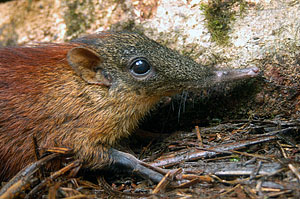 newly discovered Rhynchocyon udzungwensis
newly discovered Rhynchocyon udzungwensis
the grey-faced sengiAlthough enigmatic new species of insects are fairly common discoveries, many large animals have already made an appearance on the species list. Charismatic animals such as mammals are one of the most documented on the planet and it is now very rare to find a new species in this day and age. Yet in March 2006, Galen Rathbun of the California Academy of Sciences, along with Francesco Rovero of the Trento Musuem of Natural Science and a team of collaborators, confirmed a new mammal species - Rhynchocyon udzungwensis, or the grey-faced sengi. Their discovery was recently published in the February 4 issue of The Journal of Zoology.
Sengis are commonly known as elephant-shrews. They were first associated with elephants because of their long flexible snouts that resemble that of an elephant's trunk. Moreover, recent molecular research has shown that sengis have more in common with elephants that the shrews they were originally associated with. Their closest relatives include elephants, sea cows, and the aardvark. Until now only 15 species of sengis were known to science. In 2005, the new sengi was first caught on film. Francesco Rovero of the Trento Museum of Natural Science had been setting up camera traps inside the remote Ndundulu Forest in Tanzania's Udzungwa Mountains in order to survey the region's forest mammals. When the camera recorded the unfamiliar sengi, he sent the photos to Rathbun for identification. Rathbun was sought after for his expertise - he has studied the ecology, social structure, and evolution of sengis for more than 30 years. Rathbun believed the sengi to be a new species and embarked on a two week expedition with a team of colleagues in March 2006 to confirm his belief.
There were a few setbacks confirming the new sengi species. Rathbun had planned their trip for the dry season but the rains came early making the shrew harder to spot. The size of the sengi also posed a problem as the traps that were brought proved too small for the giant sengi. The grey-faced sengis weigh close to 1.5 pounds which is 25 percent larger than any other documented sengi. Therefore, more traditional twine snares had to be built to contain the giant sengi. Victory prevailed and the team was able to catch 4 animals and make 40 observations thus confirming the new species. "This is one of the most exciting discoveries of my career," Rathbun says. "It is the first new species of giant elephant-shrew to be discovered in more that 126 years. From the moment I first lifted one of the animals into our photography tent, I knew it must be a new species - not just because of its distinct coloring, but because it was so heavy!" More information about this expedition and other Academy expeditions can be found at http://www.calacademy.org/academy/expeditions/.
![]() Cat Aboudara is the Special Projects Manager at California Academy of Sciences and works in the public programs division. The Academy is a wonderful fit for her because of her curiosity about the natural world and her experience in working with native California wildlife.
Cat Aboudara is the Special Projects Manager at California Academy of Sciences and works in the public programs division. The Academy is a wonderful fit for her because of her curiosity about the natural world and her experience in working with native California wildlife.
